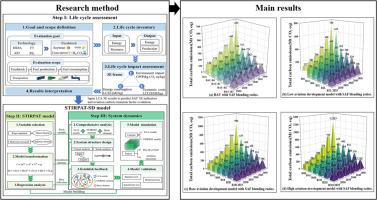基于生命周期预测模型的航空燃料可持续评价
IF 10.9
1区 环境科学与生态学
Q1 ENGINEERING, ENVIRONMENTAL
引用次数: 0
摘要
可持续航空燃料(SAF)对于航空业实现2050年净零排放目标至关重要。由于原料和工艺的不同,SAF的能源消耗、环境影响和经济成本差异很大。本研究采用生命周期评价方法评价国航路线的能源-环境-经济(3E)绩效;采用STIRPAT模型量化影响航空排放的关键因素;然后将SAF的3E指标和航空排放影响因素整合到模拟SAF航线和混合比例对航空排放影响的系统动力学模型中。结果表明:不同的SAF路由在3E方面各有优势;减少航空需求和提高飞机燃油效率是关键的减排杠杆;在2050年SAF与常规航油混合比例设定的情景下,只有85%和100%的SAF混合才能实现航空业要求的65%的碳减排目标。本文章由计算机程序翻译,如有差异,请以英文原文为准。

Evaluation of sustainable aviation fuel based on life cycle prediction model
Sustainable aviation fuel (SAF) is crucial for the aviation industry to achieve its 2050 net-zero emissions target. The energy consumption, environmental impacts, and economic costs of SAF vary significantly due to feedstocks and processes. This study applies life cycle assessment to evaluate SAF routes’ energy-environment-economy (3E) performance; uses the STIRPAT model to quantify key factors influencing aviation emissions; and then integrates 3E indicators of SAF and factors affecting aviation emissions into a system dynamics model simulating impacts of SAF routes and blending ratios on aviation emissions. The results show that: different SAF routes have their advantages in terms of 3E; reducing aviation demand and improving aircraft fuel efficiency are the key emission reduction levers; and under the set scenario of blending ratios of SAF and conventional jet fuel in 2050, only blending 85 % and 100 % SAF can achieve the 65 % carbon emission reduction target required by the aviation industry.
求助全文
通过发布文献求助,成功后即可免费获取论文全文。
去求助
来源期刊

Resources Conservation and Recycling
环境科学-工程:环境
CiteScore
22.90
自引率
6.10%
发文量
625
审稿时长
23 days
期刊介绍:
The journal Resources, Conservation & Recycling welcomes contributions from research, which consider sustainable management and conservation of resources. The journal prioritizes understanding the transformation processes crucial for transitioning toward more sustainable production and consumption systems. It highlights technological, economic, institutional, and policy aspects related to specific resource management practices such as conservation, recycling, and resource substitution, as well as broader strategies like improving resource productivity and restructuring production and consumption patterns.
Contributions may address regional, national, or international scales and can range from individual resources or technologies to entire sectors or systems. Authors are encouraged to explore scientific and methodological issues alongside practical, environmental, and economic implications. However, manuscripts focusing solely on laboratory experiments without discussing their broader implications will not be considered for publication in the journal.
 求助内容:
求助内容: 应助结果提醒方式:
应助结果提醒方式:


